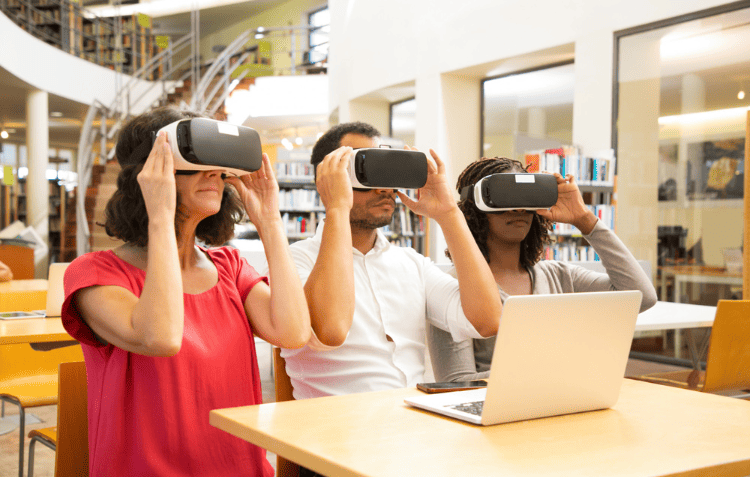Revolutionary AR VR Trends Transforming Augmented Reality in Education 2025
Introduction
In recent years, augmented reality (AR) and virtual reality (VR) have rapidly evolved from niche technologies into mainstream tools reshaping multiple industries. AR VR trends are especially prominent in education, where they are significantly impacting how students learn and engage with content. Among these sectors, education is experiencing one of the most profound impacts. As educational institutions continue to explore new ways to engage students and enhance learning, AR and VR are emerging as game-changing technologies. By merging the physical and digital worlds, AR and VR offer immersive experiences that go beyond traditional methods of teaching, opening doors to interactive and experiential learning.
This article dives into the latest AR VR trends in education and how augmented reality is paving the way for more dynamic, hands-on learning experiences, driving innovation and enhancing student outcomes.
The Growing Adoption of AR and VR in Education
Educational institutions worldwide are recognizing the benefits of AR and VR. In fact, AR VR trends indicate a growing shift toward immersive technologies that facilitate deeper engagement. With these tools, educators can create dynamic learning experiences that bring abstract concepts to life.
For instance, instead of reading about the solar system in a textbook, students can use VR headsets to take a virtual tour of outer space. In augmented reality, complex math equations can be visualized in 3D, making it easier for students to grasp difficult concepts.
According to recent industry reports, the global AR and VR market in education is expected to grow significantly in the coming years, driven by advancements in hardware and the increasing availability of affordable devices.
Key AR VR Trends in Education
Immersive Virtual Classrooms
One of the most significant AR VR trends in education today is the rise of immersive virtual classrooms. These trends highlight the transformative impact of augmented reality on how students interact with educational material. VR allows teachers to create fully virtual environments where students can interact, collaborate, and learn in ways that are not possible in a traditional classroom. This is particularly valuable for remote education, where students from different geographic locations can connect and learn together in a shared virtual space.
Augmented Reality in Textbooks and Apps
Augmented reality is making traditional textbooks more engaging. With AR-enabled books, students can scan a page with their smartphones or tablets to reveal additional layers of content, such as videos, animations, and interactive diagrams. Apps that use augmented reality for subjects like science, history, and geography are also gaining popularity, offering students a more hands-on learning experience.
Virtual Field Trips
Virtual field trips are becoming a powerful tool in education, providing students with experiences they may never have in real life. With VR, students can visit ancient civilizations, explore ecosystems, or even witness historical events as if they were there. These virtual experiences can deepen students’ understanding of the material and provide a more immersive learning experience than traditional methods.
Simulation-Based Learning
Simulation-based learning is another trend that’s gaining traction, particularly in fields like medicine and engineering. VR simulations allow students to practice complex procedures, like performing surgery or building structures, in a safe and controlled environment. This hands-on approach to learning can significantly enhance students’ skills and preparedness for real-world scenarios. As innovative technologies shaping future cities and education continue to evolve, AR and VR will likely play an even larger role in transforming these fields.
Collaborative Learning with AR
AR is also fostering collaborative learning by enabling students to work together on projects in real time. Using AR tools, students can co-create digital content, share their work, and provide feedback, all while interacting with the same augmented environment. This kind of collaboration encourages creativity and teamwork, essential skills in today’s educational landscape.
Benefits of Augmented Reality in Education
Augmented reality (AR) is proving to be a game-changer for education. By leveraging AR VR trends, educators can create immersive learning experiences that significantly enhance student engagement and understanding:
- Enhanced Engagement: AR transforms passive learning into active participation, helping to capture students’ attention and keep them engaged with the material.
- Better Retention and Understanding: By presenting information in a visually engaging way, AR helps students retain what they’ve learned better and understand complex concepts more easily.
- Personalized Learning Experiences: AR allows for customizable learning paths, enabling students to learn at their own pace and focus on areas where they need the most help.
The Future of AR and VR in Education
As AR and VR technologies continue to evolve, their applications in education are expected to expand even further. We can anticipate more sophisticated AR VR tools that cater to different learning styles, making education more accessible and inclusive.
However, challenges remain, such as the cost of AR VR equipment and ensuring that all students have access to the necessary technology. Addressing these challenges will be critical to ensuring that the benefits of AR and VR are available to all students, regardless of their socioeconomic background.
Conclusion
The integration of AR VR trends in education is just beginning, but its potential is already clear. As augmented reality (AR) continues to evolve, its role in transforming educational experiences will become even more pronounced. From virtual classrooms to simulation-based learning, AR VR trends are transforming the traditional educational model and shaping the future of learning. As more schools and universities adopt these technologies, we can expect to see even more innovative applications that will further enhance the learning experience.
Educators and institutions must stay informed about the latest AR VR trends to leverage these technologies effectively. By embracing AR and VR, we can create more engaging, immersive, and personalized educational experiences that prepare students for the future.
FAQs
What are the current trends in AR and VR in education?
The key trends include immersive virtual classrooms, augmented reality textbooks, virtual field trips, simulation-based learning, and collaborative learning using AR.
How does augmented reality benefit education?
Augmented reality enhances engagement, improves retention and understanding, and allows for personalized learning experiences by presenting interactive and visually stimulating content.
What is the future of AR and VR in education?
The future of AR and VR in education involves expanding their use to cater to diverse learning styles, making education more immersive and inclusive while addressing challenges such as cost and accessibility.
Can AR and VR be used for remote learning?
Yes, AR and VR are valuable tools for remote learning, providing immersive and interactive virtual environments where students can collaborate and learn from anywhere.
Are there any challenges to implementing AR and VR in education?
Yes, challenges include the high cost of AR and VR equipment, the need for widespread access to the technology, and training educators to effectively integrate these tools into their teaching methods.







